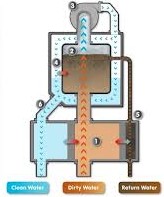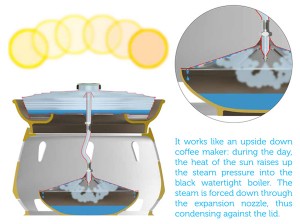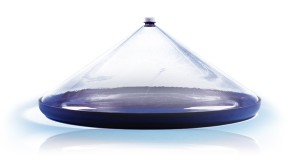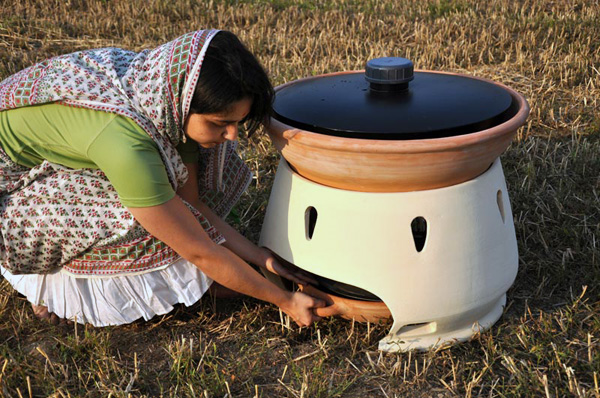This last week we learned that there is frozen water at Mercury’s poles and that water has been detected by Curiosity in its exploration of Gale Crater. Water seems to be abundant in the Solar System but increasingly scarce here on Earth. I’m not talking about oceans of water but freshwater. In previous blogs on this subject we have looked at water stressed areas of the planet. Countries and continents are facing a freshwater crisis leading to major investments in the building of large-scale desalinization projects, harvesting freshwater from saltwater sources. But desalinization on this scale doesn’t work in poor countries, or in areas experiencing freshwater shortages far away from coastlines.
I wrote some time ago about capturing water from air using inventions like the Airdrop, a technology developed by an Australian to provide water for irrigation in dry environments. But Airdrop isn’t designed for people. It only works for plants. And plants are less discriminating about water quality than humans. That’s why companies like Coca Cola are joining with entrepreneurial inventors to find ways to create potable water for communities under freshwater stress.
Slingshot
One of those projects has led to the invention of the DEKA Slingshot, a vapour compression distiller that takes any non potable water (seawater, wastewater from sewage, agricultural runoff) and distills it into freshwater using very little energy (less than a kilowatt of electricity). A single Slingshot system can purify up to 300,000 liters (approximately 80,000 gallons) of water annually at the rate of 38 liters (10 gallons) per hour. Successful field trials in 2011 provided drinking water to 1,500 school children in Ghana for over six months with very few problems. What’s in it for Coca Cola? The company, through partnering with entrepreneurial inventors hopes to improve its water use efficiency to a point where it replenishes 100% of all water used in the production of its beverage products by 2020.

Eliodomestico
DEKA and Coca Cola are not alone in pursuing development of low-cost freshwater technology. Eliodomestico is a solar water distilling system that produces 5 liters (1.3 gallons) of drinking water daily. Invented by Gabriele Diamanti, Eliodomestico is open source. That is the plans for it are made freely available to anyone who wishes to manufacture it. Basic material requirements, terra cotta clay and zinc-plated sheet metal. How does it work? Eliodomestico uses solar heat to boil source water placed within it and then collects and condenses the water vapour.

Watercone (R)
Another solar distilling device, the Watercone, can transform saltwater into freshwater at the rate of 1.5 liters (50 ounces) per day, enough for a small child’s daily needs. Invented by Stephan Augustin, a native of Germany, and manufactured and distributed worldwide by Mage Water Management GMBH, this simple device, seen in the picture below, is made from a polycarbonate plastic. It works by evaporating salty or brackish water placed in its bottom dish using sunlight. The water vapour condenses on the inner wall of the transparent cone and collects in a trough around its bottom edge. Information I have been able to gather from the web indicates a range of pricing from 20 Euros to $69 U.S. The manufacturer’s purchasing page is currently down but I will revisit.

So from high tech, the Slingshot, to low tech, the Watercone, new devices are addressing freshwater scarcity on our planet. If you uncover solutions like these please let me know and I will write about them. The more we spread the word, the better our 21st century world can become.

















((One of those projects has led to the invention of the DEKA Slingshot, a vapour compression distiller that takes any non potable water (seawater, wastewater from sewage, agricultural runoff) and distills it into freshwater using very little energy (less than a kilowatt of electricity). A single Slingshot system can purify up to 300,000 liters (approximately 80,000 gallons) of water annually at the rate of 38 liters (10 gallons) per hour. Successful field trials in 2011 provided drinking water to 1,500 school children in Ghana for over six months with very few problems. What’s in it for Coca Cola? The company, through partnering with entrepreneurial inventors hopes to improve its water use efficiency to a point where it replenishes 100% of all water used in the production of its beverage products by 2020.))
I really can’t understand the economics of this sort of apparatus/scheme. Completely discounting the equipment capital costs, the raw energy costs alone amount to about $0.10 per gallon of distilled water (ten cents kWh). Well water pumped at ten cents kWh costs about $0.001 per gallon. How much does it cost per gallon to transport well water several hundred miles by road? How many populated regions of Ghana are over 200-miles from the nearest potable water well? Are we trying to provide water to regions with no roads and no storage tanks? Are we talking about regions that have electricity (essential to power the apparatus), no roads, but the population is so inherently stupid/evil that it constantly destroys PVC water pipes that cost less than $1,000/mile (Suppose a road comes within a few miles of the site where the water is needed. Then only a few thousand dollars would buy the pipe to bring the water in.) Seems like people living in such a region need enough brains to relocate to a more civilized region more than they need drinking water. Sounds like a big company publicity stunt.
This is hardly a publicity stunt by a company. The problem is infrastructure. Whatever got built when these countries were colonies is woefully inadequate for current population centres. In addition the northern and inland parts of these countries have been experiencing significant climate change. Wells have dried up. People spend more time trekking to available water sources to get less than potable water to bring back to their homes. The governments have shown such poor judgment in developing programs to improve land use, agricultural practices and water conservation programs. The economies have become one product exporters, net importers of food. So yes….it is a total mess. The people are not nomads. They live in their traditional home areas. Sure, they could all move and many are to the cities, but that only transfers the problem of water scarcity from rural to urban settings because the infrastructure of informal settlements (shanty slums) does not exist.
As for the economics it seems according to all that I have read, there are very few places in many of these African countries where clean freshwater is readily accessible at the prices you describe. Africa, for the most part, represents a significant number of failed states and we here on this side of the Atlantic Ocean are clueless about the chaos that envelops so many on that continent.
The cause of Africa’s disease – a post-colonial generation of leaders who replaced European elitists with themselves and squirreled away billions while giving away the continent’s resources to foreign interests, putting little back into their respective countries, but skimming enough to fill Swiss banks.
In many parts of Africa kids don’t go to school because finding water and firewood takes priority. I have talked to enough African students who have escaped through sponsorship and scholarships to get to Canada and have listened to the stories of the world they came from. Talk about the wretched of the Earth.
Hopefully, projects that are underwritten by corporations like Coca Cola and others, can at least address a simple need like clean water.
((Hopefully, projects that are underwritten by corporations like Coca Cola and others, can at least address a simple need like clean water.))
Coca Cola could deliver 10 times as much potable water at one-tenth the cost merely by transporting well water. The Coca Cola water system doesn’t work without electricity. If electricity is available, it’s nearly inconceivable that well water wouldn’t be much cheaper than distilled water. It’s unbelievable that installed costs of a 10,000-gal/day electric water well in Ghana would exceed $8,000.
Would Coca Cola pay me $8,000 for every 10,000-gal/day water well I complete in Ghana? Ghana is among the most politically stable nations in Africa. On the other hand most of Ghana is less than 100-miles distant from Lake Volta or a major tributary, which could cheaply supply 10-times as much potable water as the entire country could drink. Would Coca Cola pay me $500 for every 10,000 gallons of sterile drinking water I deliver to any populated area they chose to name in Ghana? Some small remote villages would need a 15,000-gallon water storage tank for me to deliver to. I would have to operate much like the readi-mix concrete truck. If you don’t want the whole nine-yards delivered, you still have to pay for it. But unlike cement, the water would store indefinitely, and eventually be consumed. Even a village of only 50 persons would need about 100 gallons of drinking water per day. So I would need to deliver 10,000 gallons to the 50-person village every 3-months. If I had an iron-clad contract underwritten by the World Bank, or the Coca Cola Company, to deliver a total of 200,000 gallons of potable water per day at various locations somewhere in Ghana I would be netting > $5,000/day, and Ghana would have more sterile water than it could ever drink. The Coca Cola program is a publicity stunt.
The US military has a potable water supply problem at nearly all of its forward bases in Afghanistan. It solves the problem by helicopter delivery of bottled water. That water probably costs the US taxpayer over $5.00/gal delivered. Nearly all the forward bases have generators, so the Coca Cola distillation system would probably make a lot of sense for them.
Hi,
I wanted to send you a quick note because I read what you wrote about water conservation here.
I just finished helping to create an infographic about how much fresh water goes into things we do and consume. The idea is to bring a little extra awareness to what our every day impact is.
Some of the information was pretty surprising! I had no idea just how much water is needed to produce some of the foods I eat…
Anyway, after reading what you wrote, I thought you might like to use the infographic on 21st Century Tech.
It’s totally free to use, of course. If you do use it, please link back to the original source so anyone else that would like to use it can too.
The infographic is here in the original post link: http://www.lochnesswatergardens.com/pondblog/how-much-water/
Thanks!!
~ Mel
Melanie Palmero, Loch Ness Water Gardens
Tel: (864) 538-0022 | Mobile: (404) 384-7268
melanie@lochnesswatergardens.com | http://www.LochNessWaterGardens.com